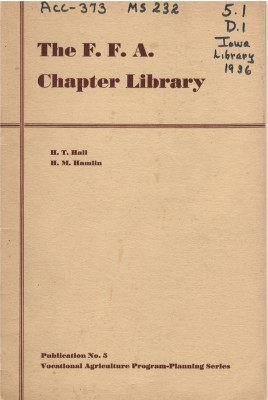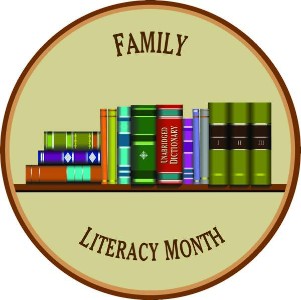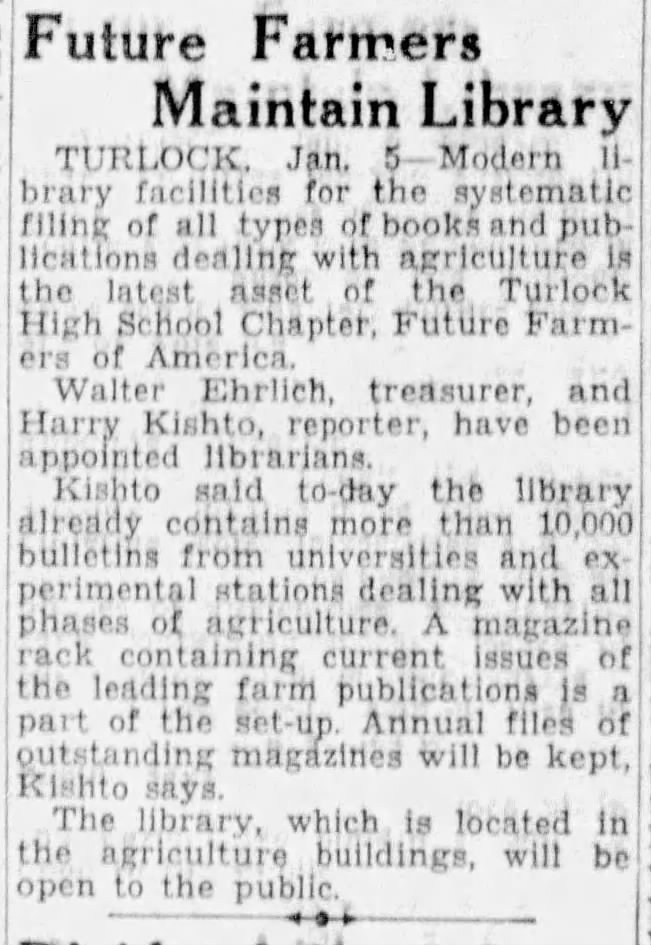Books are keys to wisdoms treasures;
Books are gates to lands of pleasures;
Books are paths that upward lead;
Books are friends. Come let us read.
– Emilie Poulson
The quotation above appeared on page 1 of a booklet titled The F.F.A. Chapter Library which was published in 1936 under the auspices of the Iowa Vocational Agriculture Program-Planning Committee. H. T. Hall and H. M. Hamlin authored the publication. We will explore this publication later in this Footnote.
Figure 1. Booklet about FFA chapter libraries published in 1936.
November is National Family Literacy Month. Started in 1994, the celebration seeks to spread awareness and foster family literacy by encouraging parents and caregivers to read to their children (National Today). So, the Friday Footnotes for November (and perhaps longer) will focus on the agricultural education family and what we, the teachers (i.e. caregivers), have done in the past and can do in the future to promote reading literacy.

Figure 2. Family Literacy Month logo
Emphasizing reading in agricultural education is not a new concept! In the early days of the FFA and agricultural education reading was emphasized, especially as it related to establishing a FFA library or a library at the home of the FFA member.
The Early Days of Agricultural Education and FFA Libraries
The need and desirability of having an agricultural library for agricultural students actually predate the FFA and even the Smith-Hughes Act of 1917. In 1912 William Hummel wrote a master’s thesis at the University of California titled “Agriculture in the High School.” This thesis served as the basis for a book published a year later by Hummel (and his librarian wife Bertha Royce Hummel) titled “Materials and Methods in High School Agriculture” which was published by the MacMillan Company.
In Chapter 5 of the Hummel book four types of equipment needed for the agriculture program are discussed (p. 93). They are 1.) the laboratory, 2.) the school farm, 3.) the agricultural library, and 4.) illustrative materials. Hummel writes (1913, p. 99), “A third important part of the equipment of high schools giving agricultural course is found in its agricultural library. Ordinarily, too little attention is given to it.” He then preceded to describe in considerable detail the organization of the agricultural library.
At the 1935 National FFA Convention the FFA Executive Secretary, W. A. Ross, reported that 2,257 FFA chapters in 43 states had school libraries and suggested that those chapters without FFA libraries start one.
Apparently, the agricultural educators in Iowa were paying attention to what Ross was saying. The 26-page booklet The F.F.A. Chapter Library was published in 1936. The booklet contains five chapters. They are:
- Chapter 1 – The Chapter Library for Self-Education and Recreation.
- Chapter 2 – Organizing and Financing a Chapter Library.
- Chapter 3 – Managing the Chapter Library
- Chapter 4 – Selected Publications (has a lengthy list of various books and magazines that would appeal to members)
- Chapter 5 – Address of Publishers
This booklet can be downloaded from the HathiTrust web site at this link.
The F.F.A. Chapter Library booklet established the rationale for a FFA library. Hall and Hamlin write (1936, p. 1):
The inadequacy of rural libraries and the inaccessibility of good reading materials have long been recognized as a handicap to those who live on the farm. A chapter library can do much to overcome this situation. Moreover, it can stimulate an interest in reading and in beneficial reading materials on the part of the members to the end that the members will make increased use of the school, county, town and other library services. Too, the members will receive some encouragement in starting and improving their home libraries.
The point that rural libraries are inadequate was an understatement. In an article titled “Who’ll Start the Library?” in the Farm Journal and Farmer’s Wife (January, 1940, p. 37) Streeter reports that 92% of farmers didn’t have access to libraries. So, it appears there was a real need for libraries in rural areas.
Also, one must remember the rural electrification was yet to come in many areas of the country and television was non-existent. After the sun went down in rural areas you would light the kerosine lamp and read or listen to a battery operated radio. Rural folks were constantly searching for good reading materials. Farm magazines often featured serialized works of fiction.
Innovators and Early Adopters
Diffusion of Innovation (DOI) Theory, developed by E.M. Rogers in 1962 explains how, over time, an idea or product gains momentum and diffuses (or spreads) through a specific population or social system. The first two stages of adopters are Innovators and Early Adopters. Some FFA chapters could be classified as innovators and early adopters in regard to chapter libraries.
Turlock High School in California was one of the early adopters of FFA libraries. According to the Modesto (CA) Bee (December 2, 1934, p. 5) Turlock High School agricultural student Harry Kishto was chosen as “librarian for the new Future Farmers library which will be open to the public soon.” The Turlock FFA library was much more than just a few books on a shelf. An article in the Modesto Bee on January 6, 1935 described the library. See Figure 3. Another article in the Modesto Bee (July 3, 1935) indicated that during the summer the FFA library would be open from 7 to 9 PM every Wednesday.

Figure 3. From the Modesto (CA) Bee, January 5, 1935.
The National FFA Gets Serious About Chapter Libraries
At the 1936 FFA Convention Ross reported the number of FFA chapter libraries had risen to 2,702 and again exhorted FFA chapters to start libraries. The need for chapter libraries was recognized by the Program of Work Committee. One of the items in the proposed 1936-37 Program of Work (POW) was for the National FFA to “Encourage and assist to build up chapter libraries.” The goal was to have 50% of FFA chapters with libraries.
At the 1937 National FFA convention the FFA chapter library received even more attention. A special committee on Chapter Libraries was appointed. The committee, chaired by Garland Daniel of Arkansas, made five recommendations (FFA Convention Proceedings, 1937, p. 33):
- That all chapters have a library consisting of at least one book for every three members.
- That these books pertain to agriculture.
- That all chapters send in a report on their libraries to the State Supervisor by the first of June, 1938.
- That these books be obtained by donations from members, purchased with money from the chapter treasury, or by other similar means.
- That these books be made available to chapter members at all times.
In addition to the committee report the National FFA Program or Work Committee again included a goal about having chapter libraries for 1937-38 and raised the goal to 75%. Apparently, the reason for raising the goal to 75% was because Executive Secretary Ross had reported that 64% of the FFA chapters had established libraries during the previous year.
In the 1938 National FFA Chapter Contest four regional winners were announced. South Hill, Virginia was the national winner. They added 60 books during the year to their chapter library. Sargent, Nebraska was a regional winner and reported that “A splendid Chapter library was developed.” Another regional winner Chester, Montana reported having 150 books and magazines in their chapter library. The message appears to be if you want to score high in the national chapter contest, you need a FFA library.
At the 1938 and 1939 National FFA Conventions a special committee on Chapter Libraries convened. The recommendations emanating from the committee were like the recommendations from 1937.
At the 1941 FFA convention FFA executive secretary Ross admonished the convention attendees to do better with the FFA library. He said (FFA Convention Proceedings, 1941, p. 71):
I hope you all noticed that only 62% of the 7,000 chapters have any kind of chapter library of helpful F. F. A. books. This is exceedingly low when compared to the suggested set of 5 or more books. When it only takes a one-board shelf in the agriculture room and 5 F. F. A. books to start, it seems reasonable to expect 100% participation on this item.
The National FFA Program of Work from 1936 until 1960 contained goals related to having chapter libraries. In 1939 the goal was to have 85% of chapters with libraries. In 1940 85% was still the goal but the program of work specified that at least one book in the library be inspirational about the FFA. In 1941 the goal was still 85% but the inspirational book requirement was changed to be at least 5 books about the FFA. In 1942 the percentage goal rose to 100% with at least five books being about the FFA. The exact same 1942 POW goal for FFA libraries was repeated in successive years until 1955.
Over the years the number of chapters steadily increased along with the number of chapters having FFA Libraries. The percentage of FFA chapters with libraries was in the 80% range during the 1950s.
The POW goal for 1955 was to “Have an adequate library” with no percentage goal listed. This item was repeated in the POW until 1960. At the 1960 FFA Convention the Official Manual Committee recommended deleting the section about the Educational Library from the FFA Manual. Starting in 1961 there was no mention of a FFA chapter library in the National Program of Work.
Concluding Remarks
Even though the emphasis from the National FFA about having chapter libraries has receded, it is still a good idea. There are numerous benefits from having a chapter library. It might even encourage students to read.
During my high school days there was a rack with magazines in the agriculture classroom. At least once a month on Friday (or was it once a week, that was a long time ago), students were required to read an article from one of the magazines and then write a report on what they read. These reports were graded by the teacher. Back then I thought perhaps the teacher just didn’t want to teach on those days. But perhaps the practice encouraged us to read, taught us something about writing, and we might have even learned a bit about agriculture. Something to think about.
Over the next month we are going to explore what the students were reading from the FFA library back then. We have some students today who might benefit from reading some of the classics from that era. We might even look at the research that compares reading comprehension as it relates to physical books and electronic books. We will conclude the series by looking at what FFA members are doing to promote reading in their communities. Stay tuned.
